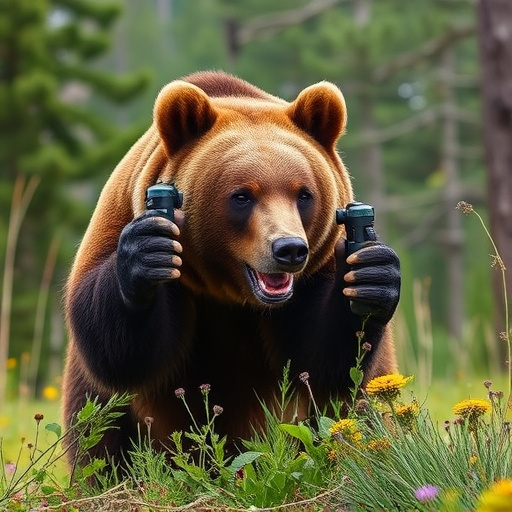To ensure safety during bear encounters, maintain an optimal distance of 20-30 feet (6-9 meters) for bear spray deployment. This range ensures direct face or eye targeting of the bear, temporarily deterring or causing it to escape. Quick draw access is crucial, achieved through strategic holster design and proper fit for swift response in bustling wilderness environments. Waist-level holsters with 2-3 foot (0.6-0.9 meter) distance from front offer balance. Regular practice and training at various distances build muscle memory and confidence for accurate, safe responses. Follow legal regulations and maintain awareness of optimal spray range for effective coverage.
In bear country, quick access to bear spray can be a matter of life and death. This article explores the crucial aspect of bear spray holster design, focusing on quick draw access and optimal distance usage. We’ll delve into the science behind bear spray range effectiveness, uncover factors that impact your ability to deploy it swiftly, and provide expert tips on holster placement and training techniques for a split-second response. Plus, we’ll discuss legal considerations and safety precautions to ensure responsible use.
- Understanding Bear Spray Range Effectiveness
- Factors Influencing Quick Draw Access
- Best Practices for Holster Placement
- Training Techniques for Optimal Response
- Legal Considerations and Safety Precautions
Understanding Bear Spray Range Effectiveness
Understanding the optimal distance for bear spray effectiveness is crucial for your safety in close encounters. The range at which bear spray is most effective varies depending on several factors, including the type of spray and the specific bear species. Typically, bear spray can be used effectively within a range of 20 to 30 feet (6 to 9 meters). This distance allows you to deploy the spray directly into the bear’s face or eyes, causing it to temporarily deter or escape.
The optimal distance is crucial because spraying from too far away may result in insufficient coverage, while spraying too close can be dangerous for both you and the bear. In most cases, the closer you are to the bear when deploying the spray, the more effective it will be. Always follow manufacturer guidelines for specific recommendations regarding range and usage instructions.
Factors Influencing Quick Draw Access
Several factors play a crucial role in achieving optimal quick draw access for bear spray. One of the primary considerations is the optimal distance for deployment—the closer an individual is to a potential bear encounter, the faster the response time should be. This means positioning the bear spray holster strategically within easy reach, allowing for split-second retrieval and application when needed.
Furthermore, the design and placement of the holster are essential. A well-designed holster with a secure yet easily accessible mechanism enables swift drawing of the spray without compromising the user’s balance or safety during an unexpected encounter in a bustling environment like wilderness trails. The right fit for the individual’s hand and body ensures smooth, instinctual operation, enhancing overall quick draw access.
Best Practices for Holster Placement
To ensure quick draw access and optimal effectiveness during an encounter with a bear, proper holster placement is crucial. The best practice is to carry your bear spray in a holster positioned at waist level, directly against your leg or hip. This allows for easy reach and quick retrieval. Aim for an optimal distance of about 2-3 feet (0.6-0.9 meters) from the front of your body; this range provides balance between accessibility and minimizing the risk of accidental discharge.
When wearing a holster, use belts or waistpacks to secure it firmly in place. Avoid loose holsters that might shift during movement. Additionally, consider the type of spray container you use; some models have clips or hooks designed for easy access without fully drawing the holster. Regularly practice drawing and re-holstering your bear spray to build muscle memory, ensuring you can react swiftly if needed.
Training Techniques for Optimal Response
Effective training is key to ensuring a swift and accurate response during a bear encounter, especially when carrying bear spray. The optimal distance for deploying bear spray is a critical aspect that requires meticulous practice. Training sessions should focus on quick-draw techniques, enabling users to react instinctively when faced with a bear. This involves drills that simulate real-life scenarios, encouraging practitioners to maintain their composure and assess the situation swiftly.
Practicing at various distances allows individuals to master the timing and precision of their spray deployment. Starting at closer ranges and gradually increasing the distance helps build confidence and muscle memory. It’s important to remember that every encounter is unique; thus, training should also include varying bear behaviors, ensuring individuals are prepared for any unexpected twists.
Legal Considerations and Safety Precautions
When carrying bear spray, understanding legal considerations and safety precautions is paramount. Each jurisdiction has its own regulations regarding the use and possession of pepper spray, including specific requirements for storage and accessibility. Always ensure your bear spray is legally obtainable and stored according to local laws. The optimal distance for deploying bear spray—typically around 20-30 feet (6-9 meters)—is a critical safety measure. This distance allows for effective coverage while giving bears enough space to retreat, potentially avoiding confrontation.
Remember that proper training in using bear spray is essential, as incorrect deployment could be ineffective or even dangerous. Keep your spray readily accessible, but avoid drawing it unless necessary, as unexpected encounters can trigger instinctive reactions. Always remain calm and follow safety protocols to ensure both your safety and the preservation of wild habitats.
When it comes to bear spray holster quick draw access, understanding the optimal distance for bear spray deployment is key. By considering factors like terrain, weather, and animal behavior, along with best practices for holster placement and effective training techniques, you can enhance your safety in bear country. Always stay informed about local regulations and safety precautions to ensure a responsible and effective response during encounters.
